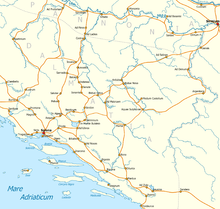Early history of Bosnia and Herzegovina
| History of Bosnia and Herzegovina |
|---|
 |
|
|
Within the boundaries of today's Bosnia and Herzegovina, there have been many layers of prehistoric cultures whose creation and disappearance are linked to migrations of unidentified ethnic groups.
Prehistory

The Paleolithic in Bosnia is marked by the oldest Paleolithic monument in southeastern Europe, the engravings in Badanj Cave near Stolac in Herzegovina. A magnificent one is Horse attacked by arrows, preserved in fragments and dated around 14000 – 12000 BC.
During the time when
Illyrian period

The bronze culture of the Illyrians, an ethnic group with a distinct culture and art form, started to organize itself in today's Slovenia, Croatia, Bosnia and Herzegovina, Serbia, Kosovo, Montenegro, Albania and parts of northern Greece.
From 8th century BC, Illyrian tribes evolved into kingdoms. The earliest recorded kingdom in Illyria (a region in the western part of the Balkan Peninsula inhabited by the Illyrians, as recorded in classical antiquity) was that of the Enchele in the 8th century BC. The era in which we observe other Illyrian kingdoms begins approximately at 400 BC and ends at 167 BC.[7] The Autariatae under Pleurias (337 BC) were considered to have been a kingdom.[8] The Kingdom of the Ardiaei (originally a tribe from the Neretva valley region) began at 230 BC and ended at 167 BC.[9] The most notable Illyrian kingdoms and dynasties were those of Bardyllis of the Dardani and of Agron of the Ardiaei who created the last and best-known Illyrian kingdom.[10] Agron ruled over the Ardiaei and had extended his rule to other tribes as well.
From the 7th century BC, bronze was replaced by iron, after which only jewelry and art objects were still made out of bronze. Illyrian tribes, under the influence of Hallstatt cultures to the north, formed regional centers that were slightly different. A very important role in their life was the cult of the dead, which is seen in their careful burials and burial ceremonies, as well as the richness of their burial sites. In northern parts, there was a long tradition of
In the 4th century BC, the first invasion of
In the
Roman period
Conflict between the Illyrians and

In the Roman period, Latin-speaking settlers from all over the
Notes
- ^ Map and information of Roman Bosnia-Herzegovina
- ^ John V. A. Fine,John Van Antwerp Fine, The Late Medieval Balkans: A Critical Survey from the Late Twelfth Century. University of Michigan Press, 1994 p.19
Sources
- Noel Malcolm, Bosnia A Short History, Macmillan London Limited, 1994.
- “Umjetničko Blago Bosne i Hercegovine”, several authors, Svjetlost, Sarajevo, 1987.
